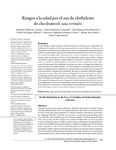
Please use this identifier to cite or link to this item:
http://ricaxcan.uaz.edu.mx/jspui/handle/20.500.11845/868| Title: | Riesgos a la salud por el uso de clorhidrato de clembuterol: una revisión |
| Other Titles: | Health Risks Due to the Use of Clenbuterol Hydrochloride: a Review |
| Authors: | Valladares Carranza, Benjamin Bañuelos Valenzuela, Romulo Peña Betancourt, Silvia Denis Velázquez Ordoñez, Valente Echavarria Chairez, Francisco Muro Reyes, Alberto Ortega Santana, César |
| Issue Date: | 2015 |
| Publisher: | Universidad de la Salle, Bogota Colombia |
| Abstract: | En este trabajo se analiza y valora la información sobre las características y riesgos del uso de clorhidrato de clembuterol (CCL) por su potencial efecto tóxico, debido a su inclusión en la alimentación animal (bovinos, cerdos, ovinos y aves) con la finalidad de mejorar parámetros productivos-reproductivos, pero que descuidan la inocuidad alimenticia. Por eso es necesario revalorar los peligros potenciales que puede ocasionar al emplearse tanto en medicina humana como en veterinaria. El CCL es un (β-adrenérgico sintético, polvo blanco, anhidro, muy soluble en agua y altamente estable a temperatura ambiente. Es utilizado en forma clandestina en animales de engorde destinados al consumo humano. Terapéuticamente, se utiliza como un medicamento broncodilatador (pacientes con asma); en competencias deportivas se ha detectado su uso ilegal (dopaje), y en fisicoculturismo es utilizado por su efecto anabólico. Su administración en el ganado para abasto modifica e incrementa el crecimiento de masas musculares, y disminuye la acumulación de grasa; se acumula en diferentes órganos. En personas con antecedente del consumo de hígado de bovino contaminado con CCL se ha registrado temblor, dolor muscular, mareos, cefalea y taquicardia. En México, de manera ilegal y clandestina, hay distribución, comercialización y uso de CCL; sin embargo, el trabajo de las organizaciones ganaderas para el registro de unidades de producción libres de esta sustancia garantizará el consumo de los productos cárnicos. Proponer el uso de otras sustancias de las cuales hasta el momento no se tiene indicios de toxicidad propiciará una productividad sustentable, segura e inocua en las unidades de producción pecuaria. |
| Description: | This paper analyzes and evaluates information about the characteristics and risks of using Clenbuterol hydrochloride (CCL) for their potential toxic effects, due to its inclusion in animal food (cattle, pigs, sheep and poultry) to improve productive-reproductive parameters, but neglecting food safety. Therefore, it is necessary to reassess the potential dangers that may result when used in both human and veterinary medicine. The (β-adrenergic synthetic CCL, white powder, anhydrous, highly water soluble and highly stable at room temperature is used in a clandestine manner to fatten animals for human consumption. Therapeutically, it is used as a bronchodilator drug (asthma patients); its illegal use (doping) has been detected in sports competitions, and it is used for bodybuilding due to its anabolic effect. Its use in cattle for slaughter modifies and increases the growth of muscle mass and reduces fat accumulation, which accumulates in different organs. In people with a history of bovine liver consumption contaminated with CCL, there has been registration of: tremor, muscle pain, dizziness, headache, and tachycardia. In Mexico, in an illegal and clandestine manner, there is distribution, marketing and use of CCL; however, the work of livestock organizations in registering production units free of this substance will ensure the consumption of meat products. Moreover, to propose the use of other substances which so far have no signs of toxicity will lead to a sustainable, secure and safe productivity in livestock units. |
| URI: | http://localhost/xmlui/handle/20.500.11845/868 https://doi.org/10.48779/64sv-aw68 |
| ISSN: | 0122-9354 |
| Other Identifiers: | info:eu-repo/semantics/publishedVersion |
| Appears in Collections: | *Documentos Académicos*-- UA Veterinaría |
Files in This Item:
| File | Description | Size | Format | |
|---|---|---|---|---|
| Revista medicina veterinaria bogota.pdf | 858,15 kB | Adobe PDF |  View/Open |
This item is licensed under a Creative Commons License
